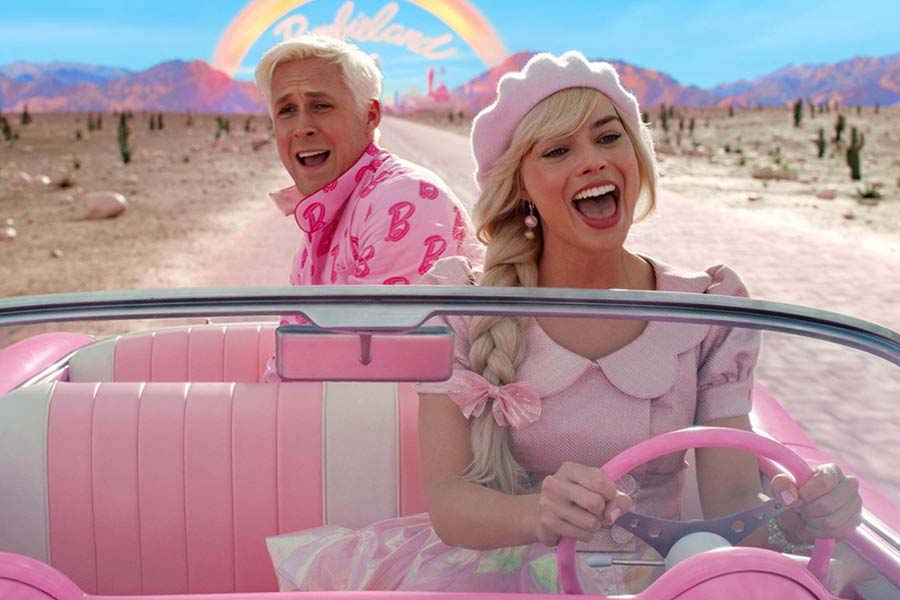Not everyone was excited about the release of Barbie, despite its robust marketing (even Chris Martin was seen breaking out into ‘I’m A Barbie Girl’ in the middle of a concert). “Too pink,’’ someone choked. “Too trivial,” said the ones who’d opted for the first-day-first-show of Oppenheimer. “Too Barbie,” said others, dismissively.
It’s true; Greta Gerwig’s Barbie is stereotypically pink. It sets up the stage for a “girly” movie, for the kind of girls who perhaps played with Barbie and then internalised those unrealistic beauty standards. The makers of Barbie went to lengths to preserve these stereotypes with their overtly pink marketing. You might have noticed, that in the run-up to the release, if you happened to google the key words associated with the movie — Greta Gerwig, Margot Robbie, Ryan Gosling and of course, Barbie — sparkles appeared on the screen and the page turned pink.
So it shouldn’t have been a surprise that at 9am at South City INOX, the first show of Barbie had most people in pink dresses, pink saris and even pink shirts. Barbie, after all, has been the hallmark of our childhoods — even if we didn’t want to play with her, we had friends who did and rest assured at least one birthday gift was a new Barbie doll with brand new accessories.
Margot Robbie and Ryan Gosling play Stereotypical Barbie and Ken with their very-blonde hair, super-cute faces and perfectly-sculpted bodies. Robbie has stated that playing Barbie “comes with a lot of baggage” but that it also evoked “a lot of nostalgic connections”. Which sums up the experience of watching Barbie.
After all the pink propaganda and getting people to play into their biases, Gerwig goes on to destroy the stereotypes we might associate with a movie about Barbie dolls. Not only is she ironic, she’s ironic about her use of irony; even if Ken tends to be a mushball and Barbie can pack a punch, Gerwig knows better than to simply signal that blonde women in pink dresses and high heels can be smart too. Twenty-two years after Legally Blonde, Gerwig is aware that the audience needs more.
A tongue-in-cheek narrative
The storytelling is tinged with irony from the very beginning where the prologue opens with a dystopian scene in which little girls are resigned to the fate of playing Mother to their baby dolls. The satirical commentary nudges us to acknowledge that society leads little girls to believe that this is what they want to do. But as soon as Barbie descends as some sort of alien-saviour in her iconic 1959 striped swimsuit, these little girls are quick to destroy their baby dolls. Of course, this is how Barbie saved womankind, isn’t that right?
We quickly realise that the narrator’s mockery is less for us humans and more for Barbie herself. Because Barbie lives far from the real world, in delirious round-the-clock happiness in Barbie Land.
Life in plastic is not actually fantastic
Gerwig’s attention to detail is arresting; Barbie lives in a front-open house and floats down as she would if a child had plucked her out of her room. She pours nothing from the milk carton and is happy to pretend-drink it, and of course, famously stands on her toes even after she’s slipped out of her high heels. Barbie Land is as plastic as our doll sets — even its inhabitants can’t dip into their solid pools and surf the hard waves, but the girls are all ridiculously satisfied… even the Barbies who’s been “discontinued” from the real world (Pregnant Midge, Growing Up Skipper, etc).
And yet, if you were expecting a version of Enchanted where a character traditionally relegated to happily-ever-after in a make-believe world is suddenly released among cynical and troubled humans, you’ve misjudged Barbie. This is far from a feel-good fairytale. In Gerwig’s world building, the real world fixes Barbie, not vice versa. When Barbie finds herself amongst humans, her ignorant, misinformed assumptions are turned upside down. She realises she’s been living in a fantasy and is ill-equipped to pave the path to happiness for the young woman she assumes is inexplicably unhappy.
The thing is, Stereotypical Barbie has been damaged because a woman played with her too hard, and now she can’t find it in herself to accept her own imperfections. It’s not Barbie who needs to tell the old woman on the park bench that she’s beautiful. The old lady is already familiar with the tenets of self love; she’s witnessed all the phases of the feminist movement. It’s Barbie who hasn’t.
Feminism 101
Barbie gets the reality check she needs, swanning about her Dreamhouse, assuming she’s saved little girls in the real world. In the male-dominated human world, Barbie has many a rude epiphany, chiefly that women have not in fact been delivered from patriarchy and sailed into positions of power like the creators of Barbie would like her to believe.
Gerwig gives her audience a comically delivered crash course in Feminism, what with Ken’s initiation into patriarchy (and the misplaced lessons he takes back with him to Barbie Land), the corporate decisions of the very male board of Mattel (the toy company which simultaneously deceives little girls and Barbie dolls) and of course a feminist rant by a woman from the real world who needs the Barbies to just get with the plot already! This classroom is simplistic, entertaining and we’re rooting for Barbie to be able to tap into her inner human.
Subjugation of Ken
Barbie Land is more than just a pink dream. Gender discrimination exists here too and turning the tables on poor, ignored Ken is just as problematic — his plight serves as a mirror into the lives of women in the real world. In Barbie Land, the senators are Barbie, Nobel Prize winners are Barbie, the president is Barbie and even the construction workers are Barbie.
No wonder she believes she saved womankind and empowered real girls to own their lives. Poor Ken simply hangs around waiting to be noticed by Barbie, which she nearly never does. With Barbie it’s always her way, it’s always Girls’ Night, and she can’t let Ken make any real decisions. I mean, who has ever given Ken time of day? But suddenly it seems to us, through all the pink-hued, sparkly happiness, that toxic feminism can be just as ugly and Ken needs to find who he really is without Barbie.

Barbie and Margot Robbie fans turned up in pink for the 9am screening of the Greta Gerwig movie at South City Mall
Gerwig builds a plastic dream world only to tear it down with her incisive irony. Robbie and Gosling are perfect as human-like plastic dolls. The young girl occupying the seat beside me in the movie hall, dressed in pink, is beside herself with excitement. She’s just gearing up for her first year at NIFT and she’d confessed at her college interview that her adoration of Barbie’s fashion had led to that moment. Somewhere in Barbie Land, Fashion Designer Barbie takes a bow.










